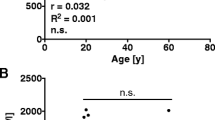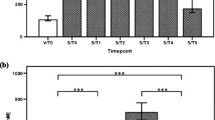Abstract
Sepsis is associated with various metabolic derangements as a consequence of inflammatory response, ischemia and oxidative stress. Four parameters of relevance are procalcitonin (PCT), ischemia modified albumin (IMA) pH and lactate. The study was carried out to highlight the concomitant occurrence of sepsis, ischemia and lactic acidosis, all of which could have deleterious effects on organ function. 26 critically ill patients with a provisional diagnosis of sepsis were the test subjects. The control group had 25 apparently healthy volunteers. PCT, lactate and IMA were assayed. PCT was estimated on an automated analyser using electro-chemiluminescence. Lactate and pH were estimated on a blood gas analyzer. Serum IMA was estimated spectrophotometrically by Albumin Cobalt Binding Test. Statistical tools like students ‘t’ test and Venn diagram were employed to depict the outcome of the study. All critically ill patients had significantly higher IMA levels (0.96746 ± 0.73407) as compared to the control group (0.00728 ± 0.00895) with a p value of <0.0001. The Venn diagram was used to depict the finding that all 26 test subjects had elevated levels of IMA, of which PCT was elevated in 22 and lactate in 20. Both PCT and lactate were abnormal in 17 patients. The most significant observation was that all critically ill patients, irrespective of the presence of sepsis or lactic acidosis had elevated levels of IMA which is clearly indicative of the ubiquitous presence of oxidative stress. The Venn diagram is an elegant representation of the concurrent multiple pathophysiological processes which occur in critically ill patients.


Similar content being viewed by others
References
Reinhart K, Bauer M, Riedermann CN, Hartog CS. New approaches to sepsis: molecular diagnostics and biomarkers. Clin Microbiol Rev. 2012;25:609–34.
Sudhir U, Venkatachalaiah RK, Kumar TA, Rao MY, Kempegowda P. Significance of serum procalcitonin in sepsis. Indian J Crit Care Med. 2011;15(1):1–5. doi:10.4103/0972-5229.78214
Dorge H, Schondube FA, Dorge P, Seipelt R, Voss M, Messmer BJ. Procalcitonin is a valuable prognostic marker in cardiac surgery but not specific for infection. Thorac Cardiovasc Surg. 2003;51:322–6.
Becker KL, Snider R, Nylen ES. Procalcitonin in sepsis and systemic inflammation: a harmful biomarker and a therapeutic target. Br J Pharmacol. 2010;159:253–64.
Gaze DC. Ischemia modified albumin: a novel biomarker for the detection of cardiac ischemia. Drug Metab Pharmacokinet. 2009;24:333–41.
Yerlikaya FH, Kurban S, Mehmetoglu I, Annagur A, Altunhan H, Erbay E, et al. Serum ischemia-modified albumin levels at diagnosis and during treatment of late-onset neonatal sepsis. J Matern Fetal Neonatal Med. 2014;27:1723–7.
Prashanth AK, Anand U. Clinical significance of ischemia modified albumin in critically ill patients with sepsis. Indian J Clin Biochem. 2015;30:194–7.
Andersen LW, Mackenhauer J, Roberts JC, Berg KM, Cocchi MN, Donnino MW. Etiology and therapeutic approach to elevated lactate. Mayo Clin Proc. 2013;88:1127–40.
Clec’h C, Ferriere F, Karuobi P, Fosse JP, Cupa M, Hoang P, et al. Diagnostic and prognostic value of procalcitonin in patients with septic shock. Crit Care Med. 2004;32:1166–9.
Chawla R, Goyal N, Calton R. Ischemia modified albumin: a novel marker for acute coronary syndromes. Indian J Clin Biochem. 2006;21:77–82.
Mikkelsen ME, Miltiades AN, Gaieski DF, Goyal M, Fuchs BD, Shah CV, et al. Serum lactate is associated with mortality in severe sepsis independent of organ failure and shock. Crit Care Med. 2009;37:1670–7.
Schwalfenberg GK. The alkaline diet: is there evidence that an alkaline pH diet benefits health? J Environ Public Health. 2012;2012:727630.
Ellidag HY, Eren E, Aydin O, Akgol E, Yalcinkaya S, Sezer C, et al. Ischemia modified albumin levels and oxidative stress in patients with bladder cancer. Asian Pac J Cancer Prev. 2013;14:2759–63.
Sinha MK, Roy D, Gaze DC, Collinson PO, Kaski JC. Role of “ischemia modified albumin”, a new biochemical marker of myocardial ischemia, in the early diagnosis of acute coronary syndromes. Emerg Med J. 2004;21:29–34.
Weiss SL, Deutschman CS. Elevated malondialdehyde levels in sepsis—something to ‘stress’ about. Crit Care. 2014;18:125.
Esterbauer H, Schaur RJ, Zollner H. Chemistry and biochemistry of 4-hydroxynonenal, malonaldehyde and related aldehydes. Free Radic Biol Med. 1991;11:81–128.
Merx MW, Weber C. Sepsis and the heart. Circulation. 2007;116:793–802.
Krishna U, Joshi SP, Modh M. An evaluation of serial blood lactate measurement as an early predictor of shock and its outcome in patients of trauma or sepsis. Indian J Crit Care Med. 2009;13:66–73.
Phypers B, Tom Pierce JM. Lactate physiology in health and disease. Contin Edu Anaesth Crit Care Pain. 2006;6:128–32.
Author information
Authors and Affiliations
Corresponding author
Ethics declarations
Conflict of interest
None.
Research Involving Human Participants and/or Animals
This work was done on samples of blood sent to the clinical biochemistry laboratory for routine investigations from patients. Tests were carried out in the left-over samples. Blood was not drawn for the purpose of the study. No animals were used in this study.
Informed Consent
General consent was obtained from patients for all investigations done. No invasive procedures were carried out in this study. Anonymity was maintained.
Rights and permissions
About this article
Cite this article
Ashok Kumar, P., Anand, U. Multiple Biomarkers to Assess the Pathophysiological State in Critically Ill Patients with Sepsis. Ind J Clin Biochem 31, 310–314 (2016). https://doi.org/10.1007/s12291-015-0525-x
Received:
Accepted:
Published:
Issue Date:
DOI: https://doi.org/10.1007/s12291-015-0525-x




